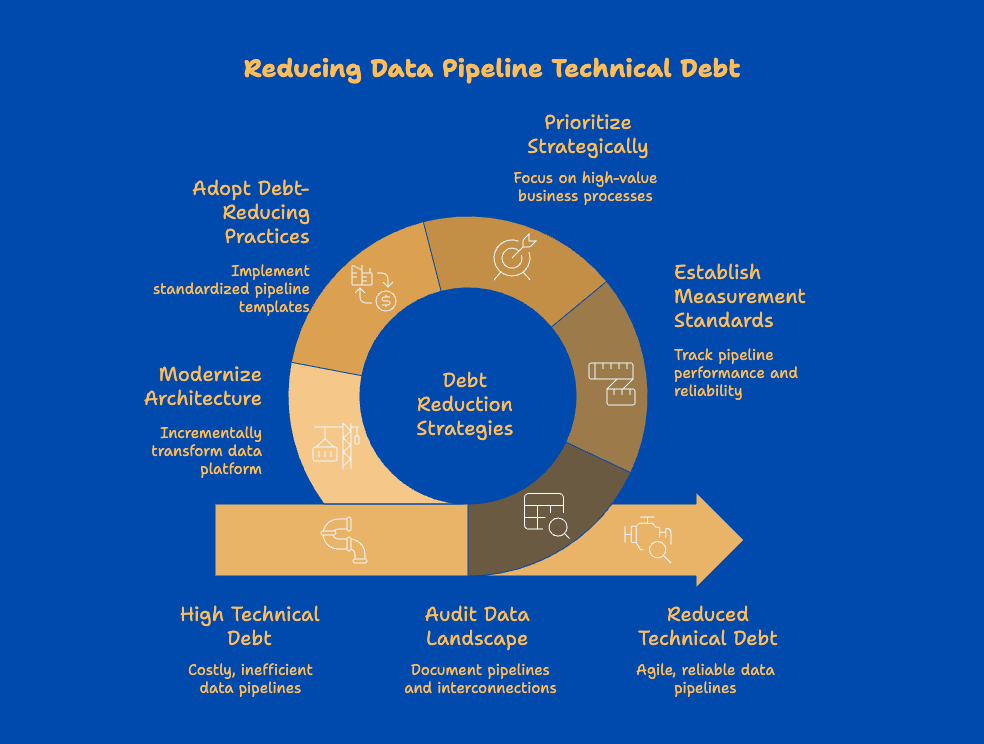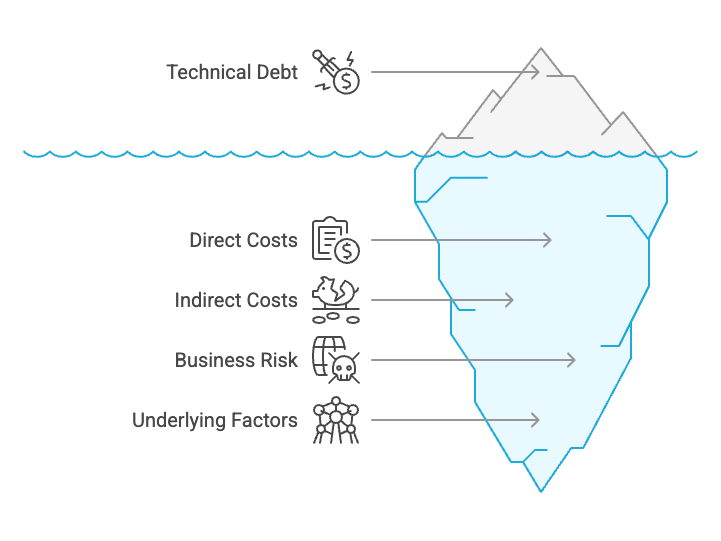#20 - The 5-Step Guide to Crushing Data Pipeline Technical Debt
Unlock five essential strategies to transform messy data pipelines into efficient, high-performing assets
Hello Data Modernizers,
This is the 3rd article in our Technical Debt in Data-Pipelines series (Part 1, Part 2).
Today, we'll explore 5 battle-tested strategies to effectively handle technical debt in your data pipelines.
Let's dive in.
The True Cost of Technical Debt in Data Pipelines
Technical debt in data pipelines isn't just a technical problem – it's a business liability with significant financial implications:
Direct Costs:
Infrastructure expenses for inefficient processing
Engineering time spent troubleshooting issues
Third-party consultants for emergency fixes
Tools to manage increasingly complex environments
Indirect Costs:
Delayed analytics and business intelligence
Lost opportunities due to data unavailability
Decreased trust in data across the organization
Employee turnover from frustration and burnout
Business Risk:
Regulatory compliance failures
Security vulnerabilities in outdated systems
Inability to adapt to changing business needs
Competitive disadvantage in time-to-insight
Example: One telecommunications company calculated that technical debt in their customer analytics pipeline cost $2.4 million annually in direct expenses and approximately $15 million in lost revenue opportunities due to delayed insights.
Breaking the Cycle: Strategies for Addressing Pipeline Technical Debt
Resolving technical debt requires a systematic approach. Here's a proven framework used by successful organizations:
1. Audit and Inventory Your Data Landscape
Start by creating a comprehensive map of your pipeline ecosystem:
Document all existing pipelines and their interconnections using automated discovery tools
Classify pipelines by business criticality, complexity, and maintenance burden
Identify redundancies and overlapping functionality across teams
Map data lineage to understand the full impact of potential changes
Assess technical debt indicators using our 7 Warning Signs framework
Create a centralized registry of all pipelines with ownership information
Quick Win: Implement automated discovery tools to generate initial pipeline inventories and visualize dependency maps. Start with your 3-5 most business-critical data flows.
2. Establish Objective Measurement Standards
Create quantifiable ways to track technical debt:
Define health metrics for pipeline performance and reliability
Implement observability for runtime, failure rates, and resource consumption
Track data quality throughout the transformation process
Measure engineering time allocation between maintenance and innovation
Calculate technical debt ratio (maintenance hours ÷ development hours)
Monitor pipeline drift through automated documentation verification
Quick Win: Deploy basic pipeline observability tools to track run times, success rates, and resource utilization. Create a simple dashboard showing these metrics over time.
3. Prioritize Strategically with Stakeholder Alignment
Focus remediation efforts where they'll deliver maximum business value:
Address critical operational issues with direct business impact first
Target high-value business processes where improved data delivery creates ROI
Identify "force multipliers" that solve multiple problems simultaneously
Consider business calendar sensitivities (avoid peak seasons for retail, etc.)
Engage business stakeholders in prioritization decisions.
Balance quick wins with strategic improvements for sustained momentum.
Quick Win: Create a technical debt register that scores issues by business impact, risk, and effort to resolve. Establish a bi-weekly technical debt review with key stakeholders.
4. Adopt Debt-Reducing Engineering Practices
Implement processes to prevent new technical debt:
Establish standardized pipeline templates to enforce best practices
Implement comprehensive pipeline testing for data quality and performance
Require documentation as part of the development process
Define clear ownership boundaries for pipeline components
Create reusable transformation libraries to reduce duplication
Implement version control for all pipeline configurations
Establish code review standards specifically for data pipeline logic
Quick Win: Deploy automated pipeline testing tools focused on data quality and validation. Implement a "no new technical debt" policy for all new development.
5. Modernize Architecture Incrementally
Gradually transform your data platform while maintaining operations:
Implement domain-driven design for pipeline organization
Adopt modern orchestration tools alongside legacy systems
Centralize transformation logic in a governed, version-controlled environment
Standardize interfaces between pipeline components
Break monolithic pipelines into modular, reusable components
Shift to declarative transformation frameworks where appropriate
Implement infrastructure-as-code for pipeline deployments
Quick Win: Evaluate tools like dbt (data build tool) that simplify transformation with SQL. Start by modernizing one high-visibility pipeline as a proof of concept.
Your 30-Day Technical Debt Reduction Action Plan
Ready to start addressing technical debt in your data pipelines? Here's your practical 30-day roadmap:
Week 1: Assessment & Baseline
Identify your 3-5 most critical data pipelines by business impact
Document current performance metrics, failure rates, and maintenance costs
Map dependencies and identify potential bottlenecks
Schedule interviews with both pipeline developers and business users
Configure basic monitoring for your critical pipelines
Week 2: Quick Wins & Documentation
Create a comprehensive inventory of known issues and workarounds
Address any immediate operational problems causing business disruption
Begin building a technical debt backlog with clear business impact
Implement basic documentation templates for critical pipelines
Start knowledge-sharing sessions to reduce key person dependencies
Week 3: Strategic Planning
Prioritize technical debt items based on business impact and effort
Develop a remediation roadmap with clear milestones and ownership
Identify resource requirements and potential automation tools
Create business cases for critical improvements with ROI calculations
Establish a regular technical debt review cadence with stakeholders
Week 4: Implementation & Momentum
Address 2-3 high-priority technical debt items from your backlog
Implement pipeline documentation standards across teams
Begin knowledge transfer sessions for critical pipelines
Establish debt prevention practices for new development
Celebrate and communicate early wins to build organizational support
The key is to start small, focus on measurable improvements, and build momentum toward a more comprehensive technical debt reduction program.
Conclusion: From Technical Debt to Technical Wealth
Technical debt in data pipelines isn't just something to eliminate – it's an opportunity to transform how your organization manages data. By addressing technical debt systematically, you're creating "technical wealth" – data infrastructure that delivers increasing returns over time.
The organizations thriving in today's data-driven environment aren't necessarily those with the biggest data teams or most advanced technologies. They're the ones that have systematically eliminated technical debt to create agile, reliable data pipelines that adapt to changing business needs.
PS...If you're enjoying the Data Modernization Insider, please consider referring this edition to a friend. They'll thank you for pointing them toward actionable insights on managing technical debt in their data pipelines.
That’s it for this week. If you found this helpful, leave a comment to let me know ✊
About the Author
With 15+ years of experience implementing data integration solutions across financial services, telecommunications, retail, and government sectors, I've helped dozens of organizations implement robust ETL processing. My approach emphasizes pragmatic implementations that deliver business value while effectively managing risk.




